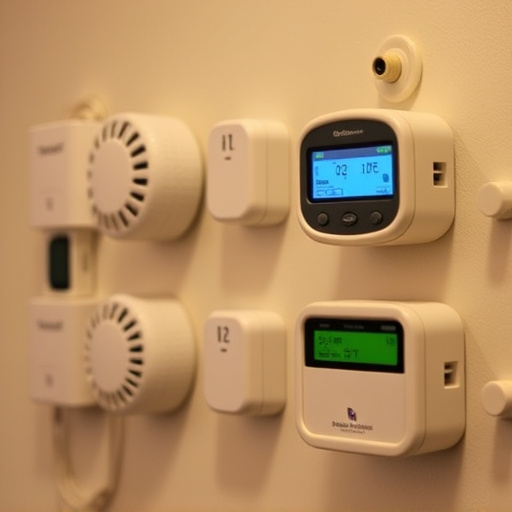Body-worn panic alarms enhance building safety with immediate distress signals, GPS tracking, and personal alarm ranges, crucial for offices, schools, and high-rises. Centralized monitoring systems swiftly respond to occupants' distress, analyze alarm data for proactive risk management, and deter potential threats, fostering safer environments in large facilities through advanced technologies like RF, Wi-Fi, and cellular networks.
In today’s world, personal safety is paramount. Body-worn panic alarms offer a vital tool for individuals seeking protection, especially in public spaces or buildings. This article delves into the comprehensive guide on understanding and leveraging these devices, focusing on monitoring. We explore the benefits of monitoring personal alarms, dissect various alarm range technologies, and provide insights on implementing these systems within buildings. Learn how effective monitoring ensures safety and enhances peace of mind.
- Understanding Body-Worn Panic Alarms
- Benefits of Monitoring Personal Alarms
- Types of Alarm Range Technologies
- Implementing Alarm Systems in Buildings
- Ensuring Safety with Effective Monitoring
Understanding Body-Worn Panic Alarms
Body-worn panic alarms are portable devices designed to provide immediate assistance during emergencies, especially in situations where individuals might be at risk or trapped within buildings. These personal alarms are typically worn like a badge or attached to clothing, making them easily accessible when needed. The primary function is to emit a loud sound that alerts nearby people or emergency services, ensuring swift response times.
One of the key features of body-worn panic alarms is their ability to enhance safety in various settings, particularly within buildings such as offices, schools, or high-rise apartments. With the push of a button, individuals can trigger an alarm signal, which includes a loud siren and often GPS tracking capabilities, allowing monitoring systems to pinpoint the wearer’s location. This technology bridges the gap between personal safety and building security by providing a Personal Alarm Range within enclosed spaces, ensuring effective communication during crises.
Benefits of Monitoring Personal Alarms
The ability to monitor personal alarms offers numerous advantages, especially within buildings where safety is paramount. By implementing a monitoring system, security personnel or designated staff can quickly respond to distress signals from occupants. This real-time tracking of personal alarms ensures that help arrives swiftly, which can be life-saving in emergency situations. For instance, if an individual activates their panic alarm while moving across a large campus or multi-story facility, the centralized monitoring system provides instant location data, enabling security teams to pinpoint and assist them promptly.
Moreover, monitoring personal alarms enhances overall building security. It allows for efficient resource allocation by providing clear insights into potential hazards or unusual activities. Security managers can analyze alarm triggers, identify recurring issues, and take proactive measures to address them. This proactive approach contributes to a safer environment, as it enables the early detection of risks, such as unauthorized access, medical emergencies, or suspicious behavior, thus improving building management and occupant well-being.
Types of Alarm Range Technologies
The effectiveness of body-worn panic alarms significantly depends on the technology behind their range and monitoring capabilities, especially in large or complex buildings where coverage is paramount. One of the most common technologies used is radio frequency (RF) transmission, which allows for a personal alarm to communicate with nearby base stations, enabling immediate assistance during emergencies. The RF signals can penetrate walls and obstacles, ensuring that individuals within a building can activate their alarms even if they’re in enclosed spaces or corners where traditional alarms might struggle to reach.
Another cutting-edge approach is the utilization of wireless technologies like Wi-Fi or cellular networks for alarm transmission. These methods are particularly advantageous in modern urban settings with robust internet infrastructure, as they can provide broader coverage and faster response times. For instance, a personal alarm equipped with Wi-Fi capabilities can send distress signals directly to emergency services via the internet, ensuring swift assistance even in high-rise buildings or crowded public spaces where traditional phone signals might be obstructed.
Implementing Alarm Systems in Buildings
Implementing alarm systems, particularly body-worn panic alarms with monitoring capabilities, is a strategic move to enhance safety within buildings. These devices offer individuals an immediate and discreet means of signaling distress, ensuring swift response during emergencies. In residential or commercial settings, integrating personal alarm ranges allows for centralized monitoring, where security personnel or designated responders can receive alerts and take prompt action.
Such systems prove invaluable in diverse environments, from high-rise offices to communal housing. By deploying body-worn alarms, buildings can create a safer atmosphere, empowering occupants with peace of mind knowing immediate assistance is available at the push of a button. Effective monitoring further reinforces security measures, acting as a powerful deterrent against potential threats and promoting a proactive approach to safety management.
Ensuring Safety with Effective Monitoring
Ensuring safety within buildings, especially large or complex structures, is paramount. One effective method is implementing a robust monitoring system alongside personal alarm devices. These alarms, often carried by individuals, can quickly alert security personnel or first responders in case of distress or an emergency. The range and coverage of these personal alarms play a crucial role in their effectiveness; they must be able to transmit signals across the entire building, including remote areas or corners that might be difficult to access.
A comprehensive monitoring system integrates with these alarms to provide real-time data and alerts. This enables security teams to swiftly locate the source of an alarm, assess the situation, and take appropriate action. By combining personal alarms and monitoring, buildings can create a safer environment for occupants, ensuring that help is always nearby, regardless of location within the facility.
Body-worn panic alarms, coupled with effective monitoring systems, significantly enhance personal safety, particularly in buildings. By integrating these devices with robust alarm range technologies, we can create safer environments. Monitoring allows for swift response to emergencies, making it a crucial component of comprehensive security strategies. When implemented correctly, as discussed in this article, body-worn panic alarms and their associated monitoring systems become invaluable tools for fostering security and peace of mind both inside and outside buildings.
